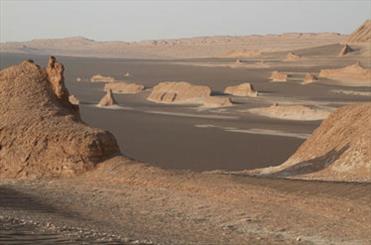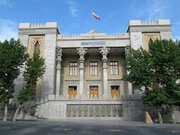With temperatures as high as 71 °C, Lut is aptly called ‘the Pole of Heat on earth.’
NASA figures show that between 2004 and 2009 (except for 2008 when Turpan Depression in north of China won the title with 68 °C) different regions in Lut desert had been the hottest spots, with extreme temperatures. The region, located in eastern Lut is predominantly salt flats of Rig-Yalan, and absorbs the most heat of the sunlight for the cream-colored wind sands in the background, thus providing the NASA an easy spot to detect for temperature estimation. This region, which covers an area of about 480 kilometers, is called Gandom Beriyan (Persian for ‘the toasted wheat’).

A spot located 75km from Rig-Yalan with 70.0 °C since 2005 has the record for the hottest place and the title Pole of Heat.

Bahman Izadi, a desert expert and the head of Kanoune Sabze Fars, an environmental NGO, believes that according to climatologists, the most precise temperature measurement is only possible in natural environment with the scientists out in the field, since “the ambient temperature, which is very important, should also be measured, in addition to surface temperature.”

Mr. Izadi gives an account of his expedition to Lut in early August along with his friends, including a documentary director to northern Lut and famous Central Trench, which is the lowest point in Iranian plateau, and which is surrounded by wider 11,000 square kilometers area of clouts.

“Expedition to Central Trench of Lut desert in the mid-summer heat is not without its own dangers; we had no option than to travel through parallel trenches surrounded by tall clouts,” he adds.

“Lut desert is a national symbol of Iran. In last November, we prepared and installed a box carrying Iran’s national flag and was meant to collect tourists memorial objects in visiting the Trench; however, we found no box, and speculated that somebody could have destroyed the landmark,” Izadi cited as public’s negligence of the national symbols.

He also said that an examination of the habitat of fauna endemic to the Central Trench indicated that in the highest temperatures reptiles had been the most active living creatures and arachnids were in the next place in terms of activity. “The only animal avoiding the heat of summer is mantoda, a praying mantis endemic to Lut desert,” said he, “the Pole of Heat, along with these features and hot and dry biosphere, the tallest of clouts, windy sand dunes, and vast drainage basin has improved Lut’s place among world heritage,” he added.
SH
MNA
END
























Your Comment